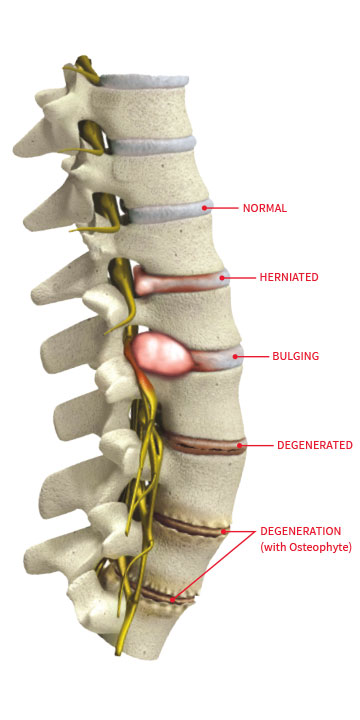Degenerated Disc
Treatment Options
Spinal discs absorb the shocks your body has to endure and over time break down. But not everybody experiences pain. If run-down discs give you pain, you might have Degenerative Disc Disease.

What is Degenerative Disc Disease
Degenerative disc disease isn’t truly a disease and almost everyone develops degenerated discs as they age. When the discs leak, people often experience pain and numbness. If there are no leaks, there are no symptoms. Nearly every degenerated disc begins as a single annular tear. The tear progressively worsens to become multiple disc tears, and then finally escalates into disc degeneration.
Almost every MRI and CT study finds that everyone over the age of 60 has some disc degeneration.
Disc degeneration often leads to chronic back pain and loss of disc height as discs continue collapsing. As regenerative medicine continues to advance in its treatment for spinal conditions such as degenerative disc disease, often physicians are looking to biologics such as stem cells, bone marrow concentrate and platelet-rich plasma to treat the degenerated discs. The problem these treatments face in the spinal discs is that once the annulus of the disc is compromised, the biologic being injected will not stay in the target treatment area. By using a particular orthobiologic, the Discseel® Procedure effectively seals compromised annulus tears in the disc, allowing for the body to recover from within and for other biologics to be used in conjunction with the Discseel Procedure.
The Discseel Procedure holds real potential for treating this debilitating condition.
Treatment for Degenerated Disc Disease
There are only 2 Phases of the Discseel® Procedure:
Phase 1: The disc is sealed and recovering
Phase 2: The disc regenerates over the year
Before you can get treated for degenerative disc disease, you must first be diagnosed. If you are coming here with the diagnosis, you are one step ahead! We simply want to inform you of the safest practice. A diagnosis can be obtained from your doctor with a medical history, a physical exam, and certain forms of imaging test, which is usually an MRI. From here the treatment options are explored.
All standard treatments for degenerative discs consist of some measure of exercise or physical therapy in order to increase the strength and flexibility of the muscles around the spine. This increases the already stifled blood flow to the spine as well. Other treatments include: Medication (anti-inflammatory, pain relievers, steroid injections, spinal fusion, artificial disc replacement, heat and cold therapy, spinal mobilization(s) and TENS (transcutaneous electrical nerve stimulation).
Although some of these procedures have had success treating some if not all symptoms of degenerative disc disease, the Discseel Procedure has consistently outperformed the aforementioned protocols and is often significantly less invasive, has a much shorter recovery time, and allows patients a greater range of motion than a spinal fusion, discectomy, or artificial disc replacement. The Discseel Procedure prompts the patient’s body to heal itself without the use of metal hardware or removal of tissue and has low risk of long term complications and opioid dependency.
Problems and Causes of Degenerative Disc Disease
Problems
The symptoms of degenerative disc disease are concentrated in the lower back, but can occur anywhere there is degeneration. They include:
- Mild to severe pain
- Pain that radiates to the buttocks and thighs
- Pain that is worse when sitting, bending, lifting or twisting
- Pain that is better when changing positions frequently
- Periods of varying pain, from a few days to a few months
- Numbness in the extremities
- Weakness in leg muscles or feet
- Muscle spasms or tension
- A feeling that your neck or back cannot support, loss of balance
One can see that there is a wide range of symptoms associated with degenerative disc disease. Despite all these, there are methods of treatment available to those who seek it.
Causes
The causes behind this condition are considered a natural part of aging. However, the condition is variable in its nature and severity with many individuals never experiencing any symptoms. There are several factors that can be considered to play a role:
- The daily activities you do, including sports
- Back injuries stemming from sports, over doing it, etc.
- The natural degeneration of a disc



